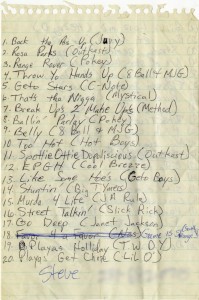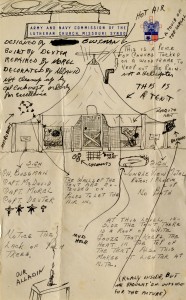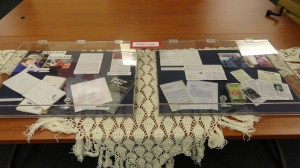
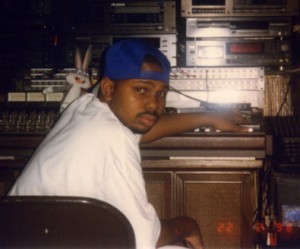 Exciting news from Special Collections: The DJ Screw Papers are now available for research! This small but important collection is a cornerstone in our Houston Hip Hop Collections and documents the influential late hip hop artist DJ Screw’s activities as a DJ and mixtape creator. Some of the materials in this collection are available for online viewing in our DJ Screw Photographs and Memorabilia Digital Collection.
Exciting news from Special Collections: The DJ Screw Papers are now available for research! This small but important collection is a cornerstone in our Houston Hip Hop Collections and documents the influential late hip hop artist DJ Screw’s activities as a DJ and mixtape creator. Some of the materials in this collection are available for online viewing in our DJ Screw Photographs and Memorabilia Digital Collection.
DJ Screw began DJing and making mixtapes as a teenager while living on the Southside of Houston. By the early 1990s, he began to develop his innovative “chopped and screwed” technique of using recording technology to repeat phrases (a process known as chopping) and slow a song’s tempo (known as screwing). DJ Screw began to receive requests to make tapes tailored for friends and local rappers. He began selling copies of these “screw tapes” from his home. The screw tapes helped to develop the careers of numerous major rappers in the Houston scene, who would subsequently become known as the Screwed Up Click (S.U.C.).
DJ Screw achieved broader popularity in the mid-1990s, and he continued to sell tapes while releasing four studio albums on Bigtyme Recordz: “All Screwed Up,” “3 ‘N The Mornin’ (Part One),” “3 ‘N The Mornin’ (Part Two),” and “I Wanna Get High with Da Blanksta.” In 1998, DJ Screw opened the store Screwed Up Records and Tapes in order to meet demand for his mixtapes.
Especially interesting items in the collection include song lists for the screw tapes, music production equipment, business documents, and photographs. If you’d like to take a look, come visit us in Special Collections!
Captain O.C. McDavid was a journalist, an artist, and, like so many of the young men of his time and age, a soldier. Special Collections holds a collection of his personal correspondence covering the breadth of his service during World War II, and a finding aid is now available online.
Captain McDavid served much of World War II stationed in the South Pacific, supporting the Allied cause by helping to establish village governments with local populations and building infrastructure to support sanitation, security, and healthcare. As with most correspondence from the war, censorship of operations and engagements with Axis forces provide scant details for those interested in the minutiae of South Pacific strategy. Instead, what emerges in these letters has as much to do with McDavid’s observations of foreign cultures as it has to do with the struggle for the South Pacific. Of particular note, given Captain McDavid’s later career and work as an artist, are the comic and compelling illustrations and sketches he uses to embellish so many of the letters back home.
As Allied troops sought out and clashed with Axis forces, McDavid’s words and pictures show us American G.I.s and their Australian allies working, living, and sharing with native New Guineans. All of this is set against the backdrop of the realities of war, evenings peppered with what McDavid describes as “The sharp staccato spitting of a machine gun. The throaty hacking of a BAR,” as he and his fellow soldiers wonder at what lurks beyond the palms in the darkness.
McDavid’s letters also reflect a resolve and pleasure towards his service and appreciation of the experience in spite of the perils. He writes home to his children:
“Many times, for sure, I’ve wished I had gotten to an overseas theatre where there’s at least some civilization. But, if I had gone over [to Europe] I probably never would, in all my life, have seen the places that lie behind the Pacific. Only read about them in the pages of the National Geographic. I would have missed the kampong poontooan and I would not have danced with an Indonesian maiden.”
Those interested in McDavid’s career as an artist and journalist will no doubt enjoy these glimpses into his formative years, while those with interest in the Pacific Theatre of World War II may be interested to look into the particulars of his work and time spent in New Guinea. We encourage you to explore the finding aid for more information and visit us if you are interested in studying this collection.
The finding aid for the Andrew Brown Texas Music Collection is now available online.
The collection consists of the research files of the Texas music historian Andrew Brown, who writes biographies and histories of music artists and record labels for books, magazines, and album liner notes.
The files are particularly strong in documenting the lives and legacies of Houston-affiliated musicians and record labels. Music scholars will be especially interested to learn that the collection includes administrative and financial files of Duke/Peacock Records. The collection also contains especially strong material pertaining to biographical information for various recording artists, publicity photographs, and songbooks.
Take a look at the contents of the collection by perusing the finding aid, or come and visit us in Special Collections to see the materials up close and in person!
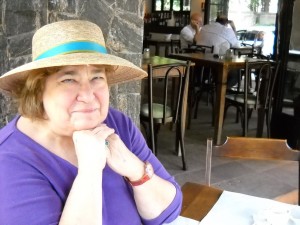 The finding aid for the Barbara Karkabi Papers is now available online. This collection includes articles written by Karkabi, correspondence, notes, and research materials.
The finding aid for the Barbara Karkabi Papers is now available online. This collection includes articles written by Karkabi, correspondence, notes, and research materials.
Barbara Karkabi was a journalist for the Houston Chronicle. In 1979 she began her career with the Chronicle generating feature stories on a variety of topics ranging from health to women and religious issues to trends in the city’s minority communities. An article she wrote in 1990 about river blindness garnered the attention of local philanthropist John Moores. In response to the story, Moores donated $25 million to an effort by a University of Houston optometry professor, William Baldwin, to distribute a highly effective drug to those in need.
Besides her work with the Chronicle, Karkabi also spent time engaged in women’s organizations. She was a long time board member of Friends of Women’s Studies, a nonprofit that supports the University of Houston’s Women’s Studies program and wrote the first story about the Carey C. Shuart Women’s Archive and Research Collection at the UH Library. Karkabi also helped found the Association for Women Journalists Houston chapter in the 1990s.
A selection of her materials was also on display at the 16th Annual Table Talk hosted by the Friends of Women’s Studies.
For more information about what is contained in the collection, be sure to take a look at the finding aid. The original materials can be viewed in the Special Collections Reading Room.
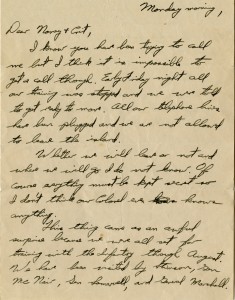 A finding aid is now available for the Kenneth W. Kennedy World War II Letters. The correspondence of Brigadier General Kennedy and his family provide an intimate glimpse of World War II life, both behind the curtain and on the stage of the North Africa Campaign.
A finding aid is now available for the Kenneth W. Kennedy World War II Letters. The correspondence of Brigadier General Kennedy and his family provide an intimate glimpse of World War II life, both behind the curtain and on the stage of the North Africa Campaign.
Kenneth W. Kennedy played the role of a young Shore Party Commander in Operation Torch as part of the invasion of Northern Africa. After the war, his engineering projects at home were numerous and included maintenance of the Mississippi River navigation channels as well as work on the early space launch facilities at Cape Canaveral. This collection of letters home during World War II not only give insight and analysis of operations in the North Africa Campaign, but also (as much as secrecy would allow) the lengthy and meticulous preparations, both in the U.S. and abroad, leading up to the invasion.
The collection dates back to Kennedy’s days at West Point and as a whole provide a telling look at the transition of an officer from peacetime to the perils of war. Letters from a number of family members, including his brother Joseph William Kennedy, are also included in the collection. Joseph William Kennedy was a member of the team to first produce and isolate plutonium at the University of California, Berkley and he would later head the Chemistry and Metallurgy division at the Los Alamos National Laboratory as work proceeded on the first atomic bombs. His letters include correspondence from both his time spent at Berkley as well as Los Alamos.
This collection, providing insights into the family and work of two brothers so critical to the war effort of the Allies, is sure to be a delight to anyone interested in the history of World War II. Curious? Take a detailed look at the finding aid or drop by the Special Collections Reading Room to view the entire collection.
